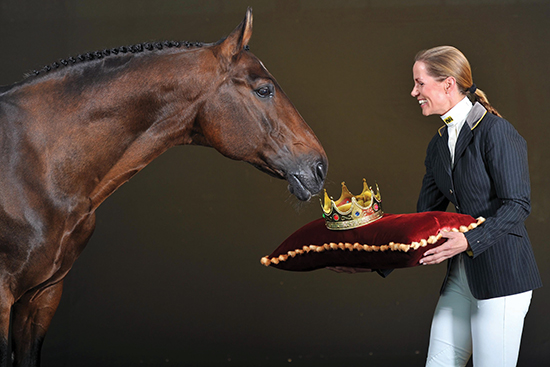
Stakkato and Eva Bitter / Photo: Kiki Beelitz
By Christopher Hector
It’s time for my annual rant about breeding values…
For the second year running, Stakkato Gold (Stakkato / Werther) is the number one ranked German jumping sire on the FN breeding stallions with a value 173 (accuracy 0.88), and he is, once again, hailed by my friend, Ludwig Christmann in his annual review in The Hanoverian:
“The outstanding success of still young descendants in international competitions verify the high breed value of 173 points. Out of 122 show horses with placings, 34 successfully compete in jumping classes at the S-level, while the oldest descendants are only ten years of age. Nine sons or daughters are recorded in the Hanoverian Stallion Yearbook with lifetime earnings of at least €15,000. Another seven horses are listed in the world rankings of the WBSFH. Shorapur out of a dam by Drosselklang II was one of last year’s most successful Hanoverians. Kevin Babington from Ireland has very successfully competed the mare for the past two years. Henrik von Eckermann just recently started riding Sansibar by Stakkato Gold/Wolkenstein II. The pair were a perfect match from the beginning, as fifth at the World Cup qualifier in Stuttgart and in the Grand Prix of Doha (Global World Champions Tour) prove. Sansibar, out of the line of Feuerkrone, is only nine years old. Stakkato Gold already ranks in the group of the top fifty jumping horse producers on the WBFSH world rankings. He is a producer at a great age. We hope not only to hear and see a lot of good from him and about him, but also that our Hanoverian jumper horse breeders use him a lot in their breeding programs.”
I wasn’t convinced when Stakkato Gold was crowned number one last year, and I am still not convinced. History shows us that great stallions of modern times have been great performers, and an injury prevented us seeing what Stakkato Gold could do in the arena – a young horse placing at Neumünster was his competition highlight before he was retired to the breeding barn.
Shorapur this year has had three wins, but they have all been at 3 star comps. Her Grand Prix win was at Lexington, and there are no stars in the placings behind her, except perhaps Margie Engel’s Royce (Café au Lait / Grandilot). The Nations Cup win at Ocala was more impressive, double clear to beat an American team that included Beezie Madden and Simon, and a fourth placed Canadian team with Yann Candel, Tiffany Foster, Ian Millar and Eric Lamaze.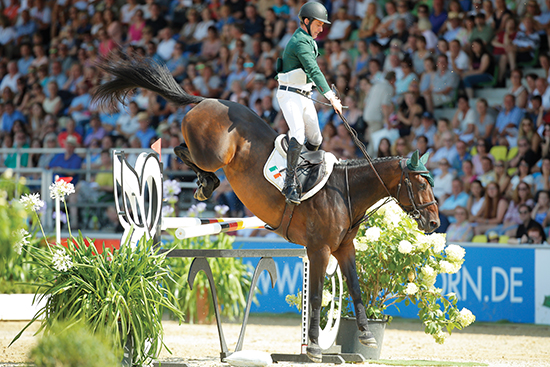
Shorapur and Kevin Babington, we guess the breeding than the riding / Photo: Stefan Lafrentz
It is an interesting result, but to put it into perspective, For Pleasure, himself a dual Olympian, who supplied three superstars at the last WEG, is ranked 26 points below Stakkato Gold, although For Pleasure (Furioso II / Grannus) does have the better accuracy rating, 0.97. For Pleasure died in 2011, and is a proven superstar sire, but to my way of thinking, Stakkato Gold is still an interesting possibility…
Stakkato Gold’s sire, Stakkato is ranked 3rd, with Perigueux by Perpignon (Pilot / Watzmann), out of a Stakkato mare, in 2nd with a value of 166. Perpignon was no star, but it is wonderful to see a stallion that carries the invaluable genes of his sire, Pilot, emerging on the scene. Pilot has been an outstanding dam sire, but finding a stallion to keep the line going has been difficult. With Perigueux celebrating the start of 2016 by taking out the 3* Glock’s Grand Prix, and his oldest progeny – just eight during last year’s competition season – looking good, he is certainly a stallion to be watched, but would you – at this stage in his career – seriously rank him above his dam sire, Stakkato, (165) or Cornet Obolensky, equal 3rd or even Obolensky’s starry son, Comme il faut, in 5th on 163?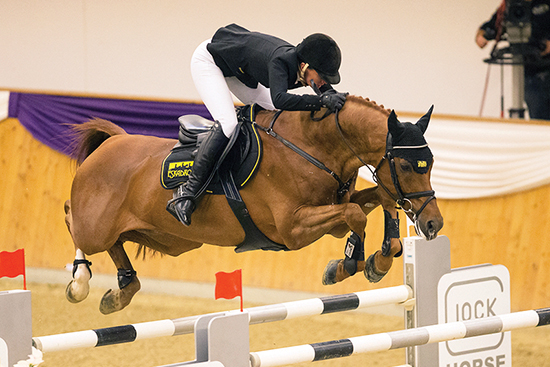
Perigueux and Eva Bitter win the Glock’s Grand Prix
The Ukranian showjumping fans, and would-be jumping horse breeders, Victor Timoschenko and Valentin Nychyporenko came to Westfalia looking for assistance to find a foundation stallion. The advice was very good, there was a Belgian bred colt, Windows van het Costerveld (by the Holsteiner jumping and breeding star, Clinton, out of a Heartbreaker mare) that topped the Westfalien stallion testing, and he was duly purchased by the Ukrainians and renamed, Cornet Obolensky.
After two years the owners contacted Ludger Beerbaum who successfully negotiated with late Leon Melchior about covering the great Ratina Z. Comme il faut was the product. At the same time the breeding visionary Miss Harli Seifert, was contacted and she agreed that Cornet Obolensky should cover the dam of Couleur Rubin, Grannuschka by Grannus, and the sport and breeding stallion Congress was the result. Both foals were owned by Mr. Timoschenko and Mr. Nychyporenko, this was agreed before covering date.
Comme il faut has been an interesting competitor with Marcus Ehning placing in Grand Prix in Dortmund, Rome, Oslo and Helsinki, but his stud duties have somewhat curtailed his competition career. His first progeny are looking good as six year olds.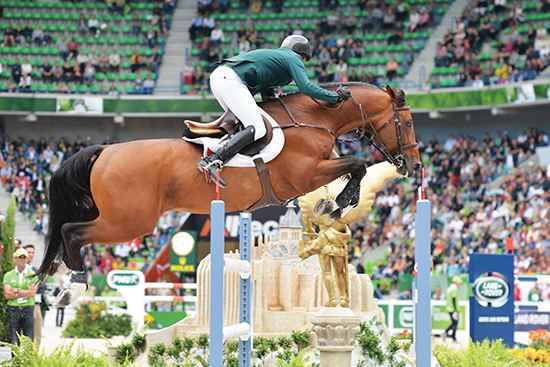
Quickly de Kreiser – number one points earner for Diamant de Semilly
The FN top ten is rounded out by two established stars, and three stallions that as far as I can see, are statistical anomalies. Comte (Contendro / Granulit) takes 5th with a value of 162. His reputation seems to rest on the success of his mares at mare shows, since his oldest offspring are seven-year-olds, and like their sire, whose career never got past novice level, have yet to make their mark in top competition.
The great Heartbreaker (Nimmerdor / Silvano) is 7th with 161, equal with Cloney (Contender / Lascadell), another whose ranking is a result of some good looking mares, since his progeny are still youngsters, and after a good performance test, Cloney’s jumping never progressed to international level.
Then we have the great Diamant de Sémilly (Le Tot de Sémilly / Elf III) star competitor, super sire, on a value of 159 ranked equal if you don’t mind with Chacco Chacco (Chacco-Blue / Stakkato / Furioso II). In 2010, Chacco Chacco was second in his performance test at Adelheidsdorf, and has been competed by Andreas Knippling. Just how fragile this ranking is, is, perhaps unconsciously, under-lined by Ludwig, who notes: “The evaluations of two of his daughters in mare performance tests, and five four year old descendants in jumper horse classes up to the L-level contributed to his breed value.”
Chacco Chacco’s career highlight was a win in a 7 year old class at Ebreichsdof in 2014, and he does not seem to have competed last year, and yet he is ranked better than Baloubet du Rouet, Contendro, Escudo, For Pleasure and Numero Uno? You’ve got to be joking.
DRESSAGE VALUES
And really things don’t get much better when we look at the top ten dressage standings. It does seem that what sets out to be a serious tool to help the breeder, has become the equine equivalent of top-of-the-pops, celebrating this year’s fashion trends. There is only one stallion in the group who has actually competed successfully at Grand Prix, Don Schufro, who is also the sire of the emerging star on the German scene, Weihegold, who just won the World Cup freestyle in Amsterdam with Isabell Werth.
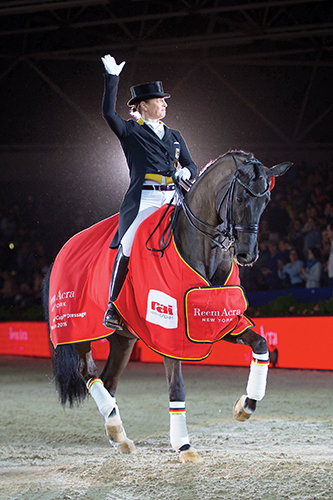
Weihegold – Grand Prix competitor by a Grand Prix competitor, Don Schufro / Photo: Arnd Bronkhorst
Heading the breeding values on 173 is Fürstenball (Fürst Heinrich / Donnerhall) a very pretty stallion that won his dressage class at the Bundeschampionate back in 2011. His first foals were born in 2010, and they have been extremely successful in mare tests, stallion performance tests, and are starting to compete in dressage. According to Ludwig, “132 descendants already competed in elementary classes, which include dressage horse classes up to the L-level. 106 returned home with at least one ribbon – that already is well-secured data!” But he concedes: “We now have to wait, if the Fürstenball descendants will fulfill the expectations at the upper level of dressage.”
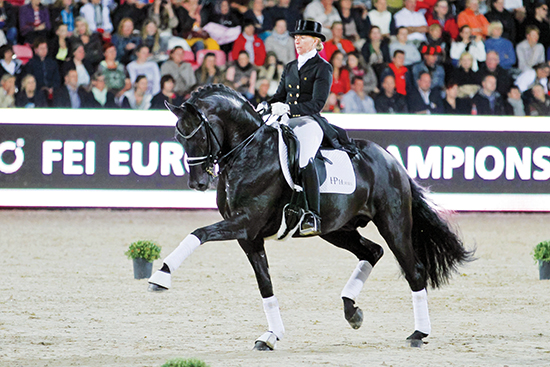
Fürstenball – number one on the dressage values
I was incredulous last year when Lissaro was proclaimed Germany’s number one dressage star, this year, he is number two on 173, and I cannot share Ludwig’s continued enthusiasm for the horse. Here is what he has to say: “He still successfully competes in dressage with Hauptsattelmeister Wolfhard Witte from the State Stud Celle. The pair obtained twelve victories in dressage classes from Inter I to Grand Prix – most of them in 2015 (They can’t have been FEI recognized classes because the stallion has no performances recorded on the FEI database)… The individual breed values in the integrated breed value estimation verify his outstanding heredity of the walk (breed value 163) and the high rideability values of his offspring (breed value 150). Fifty-nine out of seventy-nine descendants which participated in elementary classes, obtained placings. The high breed value of 130 in jumping clearly identifies Lissaro as a dual-talented stallion. A look at the horse show statistics confirms this dual talent. Three of his descendants – the oldest were six years of age in 2015 – already successfully competed in jumper classes and jumper horse classes at the M-level.”
It seems to me that while it is highly unlikely that Lissaro will emerge as a sire of Grand Prix dressage horses, he may well produce a few handy eventers…
Third place to the Dutch stallion, Vivaldi. The chestnut was another of the flash young stallions sent to Hans-Peter Minderhoud destined for Grand Prix greatness. Like a number of others, he stalled at Prix St Georges, placing 2nd in a Prix St Georges in 2012, before his owner terminated his competition career the following year and sent him to the breeding barn full-time. Vivaldi appears in 6th place on the 2014 KWPN dressage stallion breeding values for stallions with a reliability of 80% to 89%, with a value of 147 (87%). His 2015 value is 146.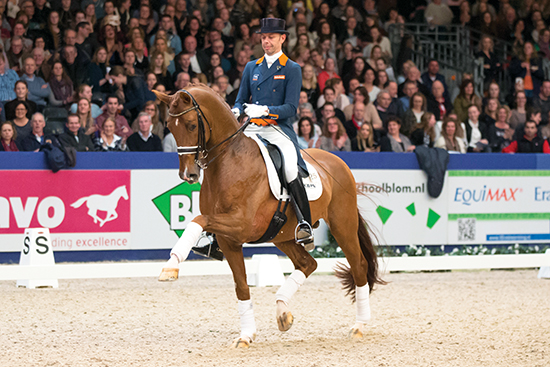
Vivaldi, the Dutch stallion is third in Germany / Photo: Dirk Caremans
By 2014, he had produced 612 KWPN progeny over the age of four, of whom 115 had been registered for competition – that’s 19.28%.
At the 2016 KWPN stallion show, Vivaldi was granted the Keur title, with the note that he ‘has produced young horse winners, approved sons and show champions.’
Don Schufro is 4th on 167, then comes Bordeaux (United / Gribaldi) and Don Juan de Hus (Jazz / Krack C) both on 166, Quaterhall (165 – Quaterback / Donnerhall), Spörken (164 – Sir Donnerhall / Lauries Crusador xx), L’Espoir (Lord Loxley / Warkant) and Real Diamond (Rohdiamant / Weltmeyer) both on 162. None of them Grand Prix competitors, but almost half of them stand, or have semen available from, Paul Schockemöhle’s stallion station.
Out of the top ten, there’s Belissimo, De Niro, Diamond Hit and Don Frederico, all of whom have produced top progeny.
When you talk to the breed administrators in Germany, over and over they worry about ‘fashion breeding’, where mare owners ignore established, proven stallions in favor of unproven youngsters – it seems strange that the German FN through its breed values, seems to be encouraging this tendency. I have been criticized for not understanding that these values point to future sires, but almost invariably they highlight horses that briefly shine before fading into obscurity. Back in 2009, Sir Donnerhall (Sandro Hit / Donnerhall) was number one on the FN charts, six years later, he can’t make the top ten.
Which leads to the question, just what is it that these breed values are measuring?
BREEDING VALUES IN HOLSTEIN
The Irish breeder, Tom Reed is a thoughtful man and I always take notice of what he writes, even if sometimes I disagree with his conclusions. Thus I was interested when he posted on Facebook:
“Here is a link to the 2015 breeding values for stallions breeding within the Holsteiner studbook. These breeding values show that on the population of Holsteiner mares most of the world-class non-Holsteiner sires have not been successful to date. Some of the foreign stallions and their sons have sired progeny with terrible scores; others are merely well below average. For example look at the scores for progeny of Baloubet du Rouet, Chaman, Darco, Kannan, etc. Does this mean these stallions are not “good”? No. What
this means is that a stallion can be great when used on a particular population of mares and destructive when used on another population of mares. It also means that breeders must learn, and insights based on rigorous evaluations must be shared, about what mares within a particular population have the best chance of producing good athletes with a particular stallion. The Holsteiner approach, which is to recognize a small number of successful foreign sires for their “breeding experiment”, allows for a concentrated focus on a relatively small number of foreign stallions whose progeny can be assessed through foal and mare inspections and mare tests. The studbook’s recent decision to allow breeders more options to use stallions successful in top sport is a natural experiement that will be interesting to follow. So if you think that the key to successful breeding is to use famous successful stallions, study this data. Hopefully they will change your mind.”
Sounds convincing, especially when you look at the numbers, and find some of the world’s most sought after stallions with negative breeding values: For Pleasure – 89, Kannan – 81, Baloubet de Rouet – 79, Channan – 64, even the late, great Darco, 62.
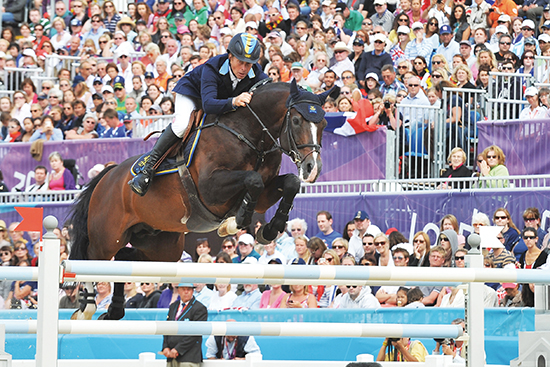 Casall – No. 1 on the Holstein breeding values
Casall – No. 1 on the Holstein breeding values
Let’s look at the top ten stallions: Casall – 140, no argument here, amazing competitor, proving a very good sire, but then it all starts to go pear-shaped, the next two highest ranked are Cormint and Chin Champ on 130, Larimar – 129, Cero – 127, Cascari – 126, Zhivago WPN – 125, Uriko WPN – 123, Stanfour – 122 and Somersby – 121. With the obvious exception, not perhaps the names that would spring to mind if you were asked to list the top ten stallions in Holstein right now…
Again the question – what are we testing? Are we testing the ability to score high breed values or the ability to sire horses that can really jump? Mare class stars, or Grand Prix winners?
Tom suggests that it is the failure of these fashionable foreign stallions to click over the Holstein mare population that produces this result, but let’s have a look at the breeding values of the older stallions, the hero sires that made Holstein great, and there we find that some of the very greatest had lousy breeding values:
Ahorn Z – 99, Cor de la Bryère(!!!!) – 96, Con Air – 94, Ramiro – 92, Cento – 91, Capitol I (!!!!!!!!) – 90 and Athlet Z – 73
And the breeding value stars?
Crawford – 131, Lucky Champ – 127, Carpaccio – 127, Calypso II – 126, Aljano – 125, Loutano – 121
I know which group I’d rather send a mare to.
This article first appeared in the April 2016 issue of THM.



Chris, I believe you got it wrong here.
The Holsteiner breeding value assesses the phenotype and basic athletic traits of foals, mares, and mares that have done an under saddle test. It is not an index for performance in sport.
If the index scores for the old time stars you referenced were high in recently published indices it would mean that that the Verband’s selection policies, and the breeders’ mating decisions, had failled miserably. It would mean that there had been no improvement over the decades and generations in type, conformation, basic gaits, and loose-jumping ability.
In other words, the “modern warmblood” in Holstein would not be modern.
Concern would arise if a stallion that had died or stopped producing progeny decades ago were still receiving high index scores. That would mean that the engine for continuous improvement built by the Verband and fueled by its members had stalled. This is clearly not the case as evidenced by the success of Holsteiners in top sport.
What the recent index scores do tell us — and what our eyes tell us — is that there has been marked improvement of the breed over recent decades. And the relatively low scores for many of the non-Holsteiner stallions in the breeding experiment reveals what we already know: Successful breeding is a lot harder than just using big name sires. That stallions can be transformative when used in one population of mares and below average (and sometimes utterly destructive) in other populations.
We must wait to see how the progeny of these lower indexed foreign stallions do (or not do) in top sport. What we do know is that, on average, many of the sires are not advancing the breed. Whether they eventually advanced the Verband’s WBFSH studbook rankings is another question. But as we know this is a rather poor indicator of true studbook quality and success in sport.
I appreciate that Tom Reed has taken the time to mount a serious critique of my argument, but remain unconvinced. Underlying Tom’s argument is the belief that improved conformation and type will improve jumping ability. Some time ago, my friend Ludwig Christmann at the Hanoverian Verband startled himself when he found that good conformation / type numbers, had a NEGATIVE correlation with jumping ability, even the score for saddle position.
Concentrating on the famous old stars, Tom ignores my point about the list of current stallions with great breeding value scores:
Casall, Cormint, Chin Champ, Larimar, Cero, Cascari, Zhivago WPN , Uriko WPN, Stanfour and Somersby. If the future success of the Holsteiner Verband lies in the efforts of this list, with the exception of Casall, the Verband is in dire straits – but it isn’t because there are much better Holsteiner jumping stallions who don’t have great breeding values. And even some of the ‘imports’ who are producing such poor types, may (will!) end up adding to the Holstein lustre.
While Casall himself contributed to the Holsteiner Verband being at the top of the WBFSH jumping standings, the stallions that made the horses in the team – Caretino, Con Air, Contender (twice), Cashandcarry and Colman – are not breeding values stars, indeed Con Air is one singled out with a very low breeding value.
My point is simply this, I see no correlation between high end breeding values, and success in the sport, and the question is are you breeding to jump fences, or look pretty on a lead rope?
– CH